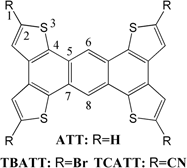Crossref Citations
This article has been cited by the following publications. This list is generated based on data provided by
Crossref.
Zhu, Rui
Li, Quan-Song
and
Li, Ze-Sheng
2018.
Nitrogen substitution improves the mobility and stability of electron transport materials for inverted perovskite solar cells.
Nanoscale,
Vol. 10,
Issue. 37,
p.
17873.
Sahoo, Smruti R.
Sahu, Sridhar
and
Sharma, Sagar
2018.
Indolocarbazole (IC) Derivatives as Promising p‐type Organic Semiconductors: A First‐Principle Study of Their Anisotropic Charge Mobilities.
ChemistrySelect,
Vol. 3,
Issue. 17,
p.
4624.
Ueberricke, Lucas
Ciubotaru, Ioana
Ghalami, Farhad
Mildner, Felix
Rominger, Frank
Elstner, Marcus
and
Mastalerz, Michael
2020.
Di‐ and Tetracyano‐Substituted Pyrene‐Fused Pyrazaacenes: Aggregation in the Solid State.
Chemistry – A European Journal,
Vol. 26,
Issue. 50,
p.
11634.
Lazaar, Koussai
Gueddida, Saber
Foerster, Dietrich
and
Said, Moncef
2020.
A theoretical investigation of the effect of fluorination and bromination on the optoelectronic properties of tetrathienophenazine derivatives.
Computational Materials Science,
Vol. 177,
Issue. ,
p.
109578.
Sahoo, Smruti Ranjan
Sharma, Sagar
and
Sahu, Sridhar
2020.
A computational study of anisotropic charge transport in air-stable fluorinated benzobisbenzothiophene (FBBBT) derivatives.
Journal of Molecular Modeling,
Vol. 26,
Issue. 1,
Nalaoh, Phattananawee
Sungworawongpana, Nathas
Chasing, Pongsakorn
Waengdongbung, Wijitra
Funchien, Patteera
Kaiyasuan, Chokchai
Sudyoadsuk, Taweesak
and
Promarak, Vinich
2021.
A Dimeric π‐Stacking of Anthracene Inducing Efficiency Enhancement in Solid‐State Fluorescence and Non‐Doped Deep‐Blue Triplet–Triplet Annihilation Organic Light‐Emitting Diodes.
Advanced Optical Materials,
Vol. 9,
Issue. 17,
Das, Sarasija
Choudhury, Anwesha
Mandal, Arnab
Kumar, Chandan
Ranjan Sahoo, Smruti
Bedi, Anjan
Shekhar Karmakar, Himadri
Gopal Ghosh, Nani
Dey, Somnath
Krishnan Iyer, Parameswar
Bhattacharyya, Sayan
and
Zade, Sanjio S.
2021.
An unconventional route to an ambipolar azaheterocycle and its in situ generated radical anion.
Organic & Biomolecular Chemistry,
Vol. 19,
Issue. 23,
p.
5114.
Lazaar, Koussai
Said, Moncef
Badawi, Michael
Lebègue, Sébastien
and
Gueddida, Saber
2021.
Effect of halogenation on the optical and electronic properties of tetrathienoanthracene and tetrathionoacridine derivatives: A DFT study.
Computational Condensed Matter,
Vol. 26,
Issue. ,
p.
e00528.
Bouba, Marius Ousmanou
Tchangnwa Nya, Fridolin
Malloum, Alhadji
Conradie, Jeanet
and
Ndjaka, Jean Marie
2022.
DFT investigation of Percyanation effect of coronene molecule: Comparative study with their Perhalogenated counterparts..
Polymer Bulletin,
Vol. 79,
Issue. 11,
p.
9663.
Das, Sarasija
Mandal, Arnab
Alam, Md. Tousif
Kumar, Chandan
Sarkar, Ayan
Senanayak, Satyaprasad P.
Bhattacharyya, Sayan
and
Zade, Sanjio S.
2022.
4nπ Stable Multitasking Azapentacene: Acidochromism, Hole Mobility, and Visible Light Photoresponse.
ACS Applied Materials & Interfaces,
Vol. 14,
Issue. 33,
p.
37982.
Guo, Qian
and
Li, Quan-Song
2023.
Enhanced Electron Mobility and Interfacial Properties by Introducing Nitrogen and Sulfur Heteroatoms into Naphthalene Diimide-Based Electron Transport Materials for Inverted Perovskite Solar Cells: A Theoretical Study.
ACS Applied Energy Materials,
Vol. 6,
Issue. 14,
p.
7433.
Dzifack Kenfack, Guy Maurel
Tchangnwa Nya, Fridolin
Ousmanou Bouba, Marius
Malloum, Alhadji
and
Conradie, Jeanet
2023.
Optoelectrical, electronic, and thermodynamic DFT study of a carbon nanoring and its derivative: application as active layer material in organic solar cell performance improvement and nonlinear optics.
Journal of Molecular Modeling,
Vol. 29,
Issue. 1,
Huang, Yao
Hu, Xuefeng
Wang, Chuanyi
and
Bahnemann, Detlef
2024.
Rational design of a donor-acceptor structured poly(3-bromothiophene) modified g-C3N4 for enhanced photocatalytic degradation of 2-mercaptobenzothiazole.
Separation and Purification Technology,
Vol. 338,
Issue. ,
p.
126457.
Aloumko, Barnabas
Tchangnwa Nya, Fridolin
Souop Tala Foadin, Crevain
Bouba Ousmanou, Marius
and
Wilson Ejuh, Geh
2024.
Doping of some corannulenes of general formula C5n2H5n (n = 2,3,4) with boron–nitride (B–N) units at the rim position: applications in electronics, optoelectronics and nonlinear optics devices.
Polymer Bulletin,
Vol. 81,
Issue. 6,
p.
4911.
Ousmanou, Marius Bouba
Yohana, Josue Zra
Tchangnwa Nya, Fridolin
Malloum, Alhadji
and
Conradie, Jeanet
2025.
Theoretical prediction of holes and electrons mobility in coronene and perchlorocoronene crystals: Application of the Marcus–Jortner–Levich Theory.
Materials Science in Semiconductor Processing,
Vol. 185,
Issue. ,
p.
108894.
